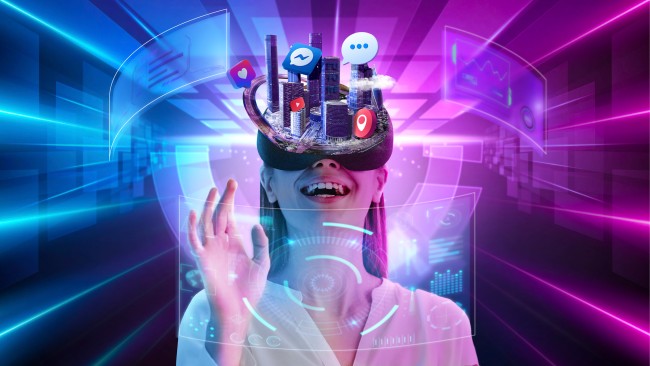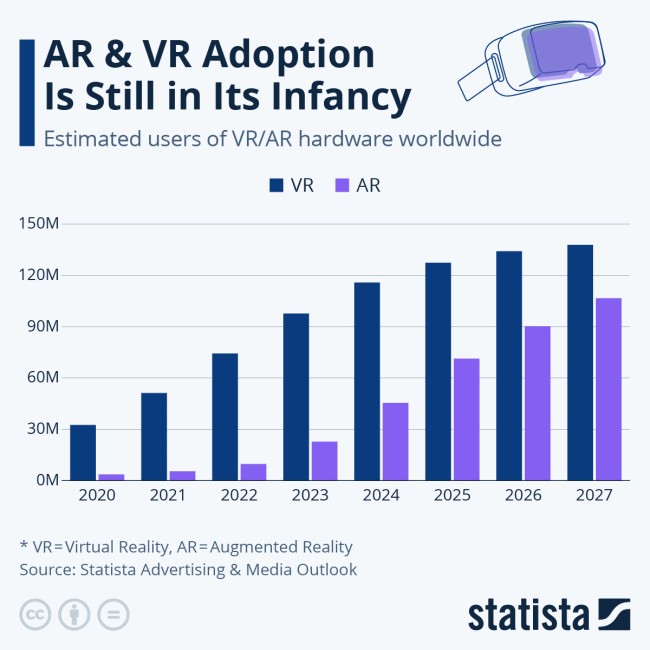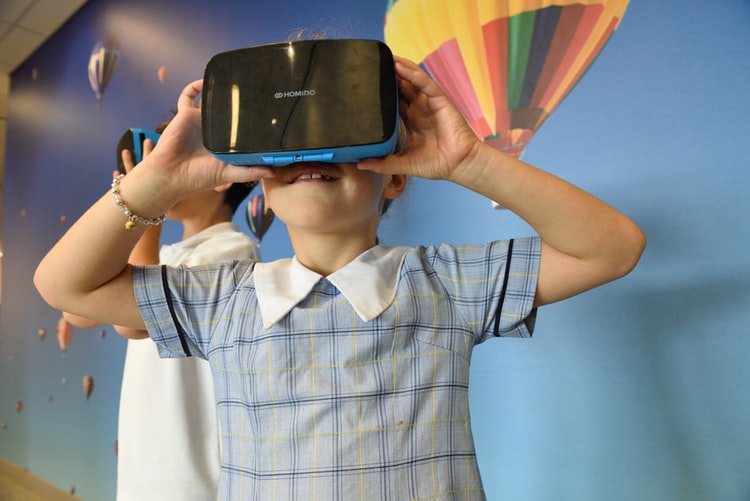
If you’re yet to experience first hand the growing virtual reality landscape, you shouldn’t be too concerned–the chances are you’ll be able to very soon.
Particularly in the field of marketing, VR solutions are emerging at a rapid pace. With the looming specter of the metaverse set to take the industry by storm, there’s little doubt that virtual reality will become a key technology across a broad range of sectors.
The beauty of virtual reality when used for marketing purposes is that it can leverage highly personal and immersive experiences for its users–helping to forge stronger bonds and recognition for brands online.
This gives marketers the opportunity to make their brands instantly recognizable from anywhere in the world, even if their business doesn’t have a physical presence in certain nations.

As Statista data shows, virtual reality adoption is still expected to double in the coming five years, while augmented reality has been forecasted to grow at an exponential rate.
With the quality of experiences that VR can bring its users, marketers have the potential to not only bolster their buyer awareness, but also advertise products in a more engaging manner, accelerate their conversion funnels, and build buyer intent through greater personalization efforts to name just a few potential applications.
With this in mind, let’s take a deeper look at six key ways in which VR promises to revolutionize marketing in 2023 and beyond:
1. Delivering Unforgettable Experiences for Customers
Virtual reality has the power to help customers to immerse themselves into your products and really discover how they can add value to their lives.
In many ways, the VR product experience can become greater than looking at items in real-world environments. This is because virtual reality can allow marketers to control the environment that surrounds customers.
By creating high-quality rendered products in a virtual environment, you can not only allow customers to explore the items themselves but also offer demonstrations and supporting props to show exactly how they can cater to their needs.
This paves the way for marketers to focus more on the worlds that surround their brand or products. VR opens the door for experience marketing in a way that more traditional approaches couldn’t dream of–and really rewards creativity from industry professionals.
2. The Next Iteration of ‘Try-Before-You-Buy’

Virtual reality also has the power to eliminate one of the biggest barriers to online shopping: the inability to try on products.
We’re already seeing VR deliver accurately rendered try-on experiences for shoppers online, helping customers to see how clothing items would look on them, or what furniture would look like in certain areas of their home.
As technologies like the metaverse continue to evolve, this try-on process will become more seamless, with users capable of shopping in virtual stores and digitally picking up and trying on products.
Particularly for companies like IKEA, which specialize in homewear of all kinds, the ability to minimize the rate of returns from customers who aren’t happy with how their products look can save a fortune in costs whilst helping shoppers to discover greater rates of buyer satisfaction.
3. Fine-Tune Personalization
According to Bernard May, CEO of digital marketing hub, National Positions, virtual reality will also be capable of delivering highly targeted personalized marketing campaigns that can help to appeal to each individual lead’s interests, wants, and needs.
“Both VR and AR technologies open the door to personalized ad experiences that are unique to every individual,” May explained. “Programmatic advertising, messaging and marketing at the individual level is one of marketing’s ‘holy grails,’ and this future will soon be part of our daily lives.”
Programmatic advertising in the age of virtual reality and big data means that marketers can create campaigns that are automatically adapted to each lead in an immersive way–helping them to have more positive experiences surrounding a brand or product.
4. Working Alongside Big Data for Stronger Impressions

The immersive experiences that virtual reality can bring to customers can also help to deliver big data insights into their audience. In the age of GDPR, it can be tricky for marketers to gain access to the data they need in order to fully understand who they’re marketing to.
But through enjoyable VR experiences, users have new cause to provide consent to their data in order to gain access to virtual reality product try-ons, games, and other immersive experiences.
The VR programs themselves can also deliver high-quality insights into what aspects of their experience customers enjoyed the most and which products they interacted with and in what way.
This level of marketing insights is difficult to replicate for online businesses today, and can be a great way of fine-tuning a winning CRO strategy.
5. Strategic Internal Onboarding for Staff
Virtual reality can not only help to support the marketing cause in a direct sense, but it can also act as an excellent tool in onboarding the talent of tomorrow in a more efficient manner.
As workplaces become increasingly remote throughout the marketing sector, VR onboarding programs can help new recruits to train in their new job roles in a more engaging way–and they even have the potential to virtually meet their colleagues and virtually collaborate.
Virtually rendered scenarios and issues can allow employees to learn how to deal with complex problems without having any risk attached to the outcome, helping staff to learn without any negative ramifications for the business.
6. Embracing the Limitless Potential of the Metaverse
We’ve already touched on the metaverse a couple of times within this article but it’s certainly worth emphasizing further. The sprawling potential of the digital worlds powered by the metaverse will pave the way for marketing opportunities that were unimaginable just a few years ago.

We’re already seeing renowned brands like Gucci, Nike, McDonald’s, Samsung, and Etsy create their very own virtual locations within the metaverse, inviting users to visit, interact, and play games themed around their respective brands.
Gucci has even enabled visitors to purchase digital items of clothing from their store to help kit out their Roblox avatars as a brand new avenue of brand engagement.
Netflix also recently entered the world of the metaverse by using a digital space to promote its movie, The Gray Man. Taking the form of a game, visitors were invited to navigate a VR maze by answering questions about the movie and winning prizes along the way.
Although the metaverse is still many years away from realizing its potential, we’ll see marketing within these virtual worlds accelerate in 2023 as approaches become more refined and VR adoption continues.
While VR adoption steadily continues to grow, marketers will certainly be keeping an eye on how they can promote better brand awareness and leverage more conversions through the use of virtual spaces.
With the specter of the metaverse ready to disrupt traditional campaigns in the coming years, the teams that move fastest to embrace the vast potential of tomorrow are likely to begin reaping the rewards today.
